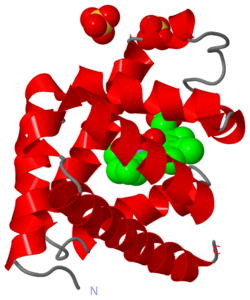JMS/sandbox22
From Proteopedia
(Difference between revisions)
| Line 1: | Line 1: | ||
| - | <StructureSection load='' size='500' side='right' caption='myoglobin (PDB entry [[ | + | <StructureSection load='' size='500' side='right' caption='myoglobin (PDB entry [[1u3d]])' scene='58/585079/1u3d_magnet/2'> |
<!-- <StructureSection load='1mbn' size='350' side='right' caption='myoglobin (PDB entry [[1mbn]])' scene='57/575026/Electrostatics/10'> --> | <!-- <StructureSection load='1mbn' size='350' side='right' caption='myoglobin (PDB entry [[1mbn]])' scene='57/575026/Electrostatics/10'> --> | ||
[[Image:1a6m.png|250px|left]] | [[Image:1a6m.png|250px|left]] | ||
| Line 9: | Line 9: | ||
'''Elephants''' can hold their breath for 2 minutes, but whales can hold their breath for 90 minutes - and they do, migrating underwater around the world. To find out how, a group of researchers contacted museums and zoos around the world<ref name="whaleMyo"> DOI:10.1126/science.1234192</ref>. | '''Elephants''' can hold their breath for 2 minutes, but whales can hold their breath for 90 minutes - and they do, migrating underwater around the world. To find out how, a group of researchers contacted museums and zoos around the world<ref name="whaleMyo"> DOI:10.1126/science.1234192</ref>. | ||
| - | |||
| - | '''They hypothesized that a vital element of whales''' and other aquatic animals' ability to hold their breath for so long is storage of more oxygen in their muscles by increasing the concentration of '''[[Myoglobin]]''', the protein that stores oxygen in muscle tissue. | ||
| - | |||
| - | Specifically, they predicted that species could increase the concentration of myoglobin by increasing its solubility through increasing the number of positively charged regions on the protein's surface, so that even at high concentration the electrostatic repulsion between the myoglobin proteins would prevent their aggregation. | ||
| - | |||
| - | '''Amazingly, they found an association''' between an animals' ability to hold its breath, higher concentrations of myoglobin in muscle tissue, and an increase in its net charge (taken as a ''proxy'' for an increase in the number of positively charged regions on the surface). Typically, purified terrestrial mammal's myoglobin has a solubility of 20 mg/g in an aqueous solution at neutral pH ([http://www.sigmaaldrich.com/content/dam/sigma-aldrich/docs/Sigma/Product_Information_Sheet/2/m0630pis.pdf Sigma Aldrich]) which turns out to be the maximum level of myoglobin found in most terrestrial mammal's tissue. But whales and other aquatic mammals far exceed this solubility limit, e.g., whales have 70 mg/g. The way that they overcome the solubility constraint may be traced back to a modest increase in the net charge of myoglobin - from around +2 in terrestrial animals to around +4 in aquatic animals. | ||
---- | ---- | ||
| Line 22: | Line 16: | ||
'''Molecular Tour:''' | '''Molecular Tour:''' | ||
| - | + | <scene name='58/585079/1u3d_magnet/1'>TextToBeDisplayed</scene> | |
| - | + | <scene name='58/585079/1u3d_magnet/2'>TextToBeDisplayed</scene> | |
| - | + | ||
| - | + | ||
| - | + | ||
| - | + | ||
| - | + | ||
<!-- | <!-- | ||
Revision as of 20:03, 12 May 2014
| |||||||||||
References:
- ↑ Mirceta S, Signore AV, Burns JM, Cossins AR, Campbell KL, Berenbrink M. Evolution of mammalian diving capacity traced by myoglobin net surface charge. Science. 2013 Jun 14;340(6138):1234192. doi: 10.1126/science.1234192. PMID:23766330 doi:http://dx.doi.org/10.1126/science.1234192

